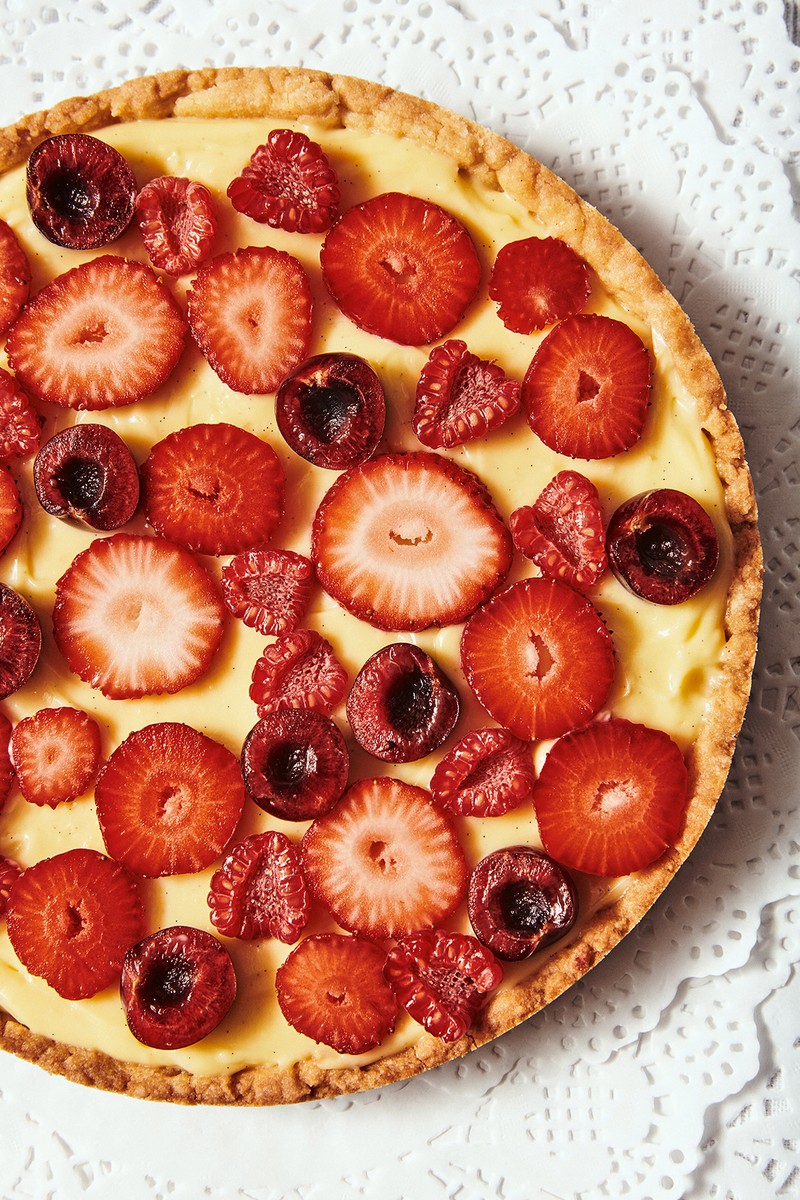3 Great Alison Roman Bakes To Try This Weekend
Something I hear all the time when I bring up desserts is, ‘I can cook, but I can’t bake.’ Of course, I know why people say or think that: conventional wisdom suggests that cooking is wild and free, encouraging creativity and improvisation. Desserts, on the other hand, should be tidy and precise. Prim, proper, controlled. Scientific, even. But as someone who would never be described as tidy or precise, who is not prim or proper, who is not a scientist, I reject those sentiments. I am a person who will use only one bowl to mix a cake batter if it means I don’t have to wash another thing, who will avoid using anything that gets plugged in at all costs, even if (or especially when) it means whipping cream by hand. Desserts, baking, whatever we want to call it, should be for anyone, at any time, requiring little more than two hands and a modicum of patience.
I wanted to write a dessert book that celebrated the excellence of basicness rather than distract with needless complexities. Most have suggestions for you to fancy things up as you wish, which will always be easy when you have a great, reliable and fool-proof base recipe to start with. You have to walk before you run, etc. My hope for you, reading the book and hopefully baking (or assembling) your way through it, is that you strive for the animalistically irresistible, not the aesthetically pristine – I find the two are rarely the same. Think of the best piece of fruit you’ve ever had, likely falling apart on the way to your mouth, juices dribbling down your forearm. Or maybe a lasagne, too cheesy and delicious to be willingly cut into perfect squares.
Maybe I’m just compensating for the fact that despite my formal training as a pastry chef in a restaurant kitchen, combined with additional years of baking and whisking and pouring and scraping and stacking and rolling and folding, I’m still not an expert. My pies still leak, cheesecakes crack, and pound cakes are pulled from the oven before they’re fully baked. Lopsided and wonky, occasionally almost burned, unevenly frosted, my desserts are consistently imperfect. But perfection is boring, and these recipes – baked longer than you think, so the edges caramelise and stay crunchy; seasoned with enough salt to taste the butter; just sweet enough with sugar to qualify as dessert, but not so much that you can’t taste the sour, the bitter, the salt and the fruit – well, damn, if they aren’t delicious. And when they come out of your kitchen, I hope you too feel they’re full of joy, imperfections and all.
Inspired? Here Are Three Bakes To Try At Home...

Perfect Tangy Chocolate Tart
If you, like me, trend towards fruit and vanilla over chocolate, I feel confident you could still fall in love with this perfectly basic, straightforward, yet completely above average chocolate tart. This one is easy to execute, flawless each and every time, doable by even those who have never so much as melted chocolate, let alone dared make a chocolate tart. If you scanned the ingredients and thought ‘milk chocolate? I’d never,’ then consider this my plea – my ask-on-hands-and-knees plea – to please trust me here and try it. I’m certain you’ll find it plenty chocolatey and even more well balanced than your typical tart. Oh, and not that you would, but please don’t skimp on the salt.
Make the crust: preheat the oven to 180°C. In a medium bowl, combine the flour, cocoa powder, icing sugar and salt. Drizzle in the melted butter and mix until well combined; it’ll have a texture sort of like Play-Doh. Press this into the bottom and up the side of a 23cm tart tin with a removable base. Use a measuring cup or your hands to flatten the crust, and make sure it’s all packed and even.
Bake until the crust is completely cooked through and has gone from dark brown and shiny to a lighter dark brown and matte, 15-20 minutes. It can be difficult to tell when this is done, because it’s already brown. Test by pressing the centre: it should be firm and opaque, not squishy or greasy looking. Remove from the oven and let cool completely.
Make the filling: in a heatproof medium bowl, combine the dark and milk chocolates and salt. Set aside.
In a small saucepan, heat the thick cream and honey over medium heat. Once it starts to simmer, remove from the heat (do not let it boil) and pour it over the chocolate. Let it sit for a minute or two to melt the chocolate, then, using a spatula, mix until well blended and no pieces of chocolate remain. (You can whisk, but be cautious of air bubbles.)
Stir in the sour cream and mix until it looks thick, glossy and emulsified. Immediately pour the filling into the cooled crust and smooth the top. Sprinkle with flaky salt and refrigerate for at least 1 hour before slicing.

Simple Fruit Tart
I love this basic, elegant, classy tart. It’s reserved and restrained, it’s prim and proper, it’s creamy and delicious. It’s also one of the more flexible desserts in this book, and if you’re the type of baker who loves to arrange your fruit like a gorgeous mosaic, well, this recipe is for you. Three distinct components, comprising an easy shortbread-like press-in crust, silky vanilla custard, and whatever fruit strikes you as most lovely when it comes time to make this tart. Since the crust and custard already give you something so fantastic, whatever you choose to top it with is truly a cherry on top, no pun intended – unless you’re using cherries, then definitely pun intended.
Make the cream: in a medium pot, combine the milk and 110g of the sugar. If using the vanilla bean, scrape the seeds into the milk and add the pod (if using vanilla extract, it goes in later). Bring to a simmer over medium heat, but do not let it boil. Once simmering, remove from the heat.
Meanwhile, in a medium bowl, whisk the remaining sugar with the egg yolks, cornflour, salt and vanilla extract (if using). While whisking, slowly pour a cup of the hot milk mixture into the egg yolk mixture and whisk to blend. Do this until all the milk has been incorporated. The mixture will be loose with a starchy texture.
Return the mixture to the pot and place over medium heat. Whisk constantly, cooking until the liquid changes from thin with many small bubbles (almost like a cappuccino) to thick and gelatinous with sporadic large bubbles, bubbling from the great depths of the pot, 8-10 minutes. The mixture will have gone from soupy liquid to golden pudding faster than you think. Remove from the heat and whisk in the butter.
Transfer to a shallow baking dish or bowl and place a piece of plastic wrap or baking paper directly on top (to prevent a ‘skin’ forming). Place in the fridge and chill completely until ready to use.
Make the crust: preheat the oven to 180°C.
In a medium bowl, combine the flour, icing sugar and salt. Using your fingers, incorporate the melted butter until you have a crumbly dough, with a texture like Play-Doh. Resist the urge to knead the dough, as you don’t want to develop any gluten (that’s how the crust shrinks on you).
Press the dough into a 23cm tart tin with a removable base, or a 23cm springform tin. Use the tines of a fork or the tip of a knife to lightly prick the top all over (to allow steam to escape as it bakes).
Bake until the bottom of the crust is golden brown, and the edges are the colour of a nicely golden shortbread cookie, 18-20 minutes. (This tart does not get baked again, so this is your chance to fully bake through.) Remove from the oven and let cool completely.
Assemble the tart: once the tart shell has cooled, whisk the vanilla pastry cream until it’s totally smooth. (It will look firm, lumpy and like cottage cheese until it smooths out and comes together, looking like the gorgeous smooth pudding it once was.) Spread this into the tart shell.
Top with fruit of your choosing; for the simplest version, use lovely uncooked berries, preferably all from the same colour family. Strawberries thinly sliced crossways to expose their circular core, raspberries either left whole or cut in half, redcurrants if you can find them.
Refrigerate for 1 hour or so to set and chill before slicing.

Tangy Buttermilk Pie
This pie, in all its humble basicness, is truly spectacular. The custard, tasting of the tangiest buttermilk, melts into the buttery, salty crust, creating a mysterious middle layer: softer than the crunchy base and more substantive than the silky top layer, behaving almost like the lemon bar of your dreams (except there’s no lemon). How buttermilk, vinegar and digestive biscuits could create something so phenomenal, I simply don’t know.
Preheat the oven to 165°C. Crush the crackers in a food processor or by hand (place them in a zip-top bag and crush with a rolling pin). In a medium bowl, mix them with the 2 tablespoons of sugar. Pour in the melted butter and mix until you have a texture like wet sand.
Using the palm of your hand or the bottom of a measuring cup, press the mixture into a 23cm tart tin or pie dish, making sure the sides are reinforced and packed tightly before focusing on the base.
Bake the crust until golden brown on the edges, 10-15 minutes. It can be tricky to tell since the crackers are already golden, but they’ll have a noticeably toastier look. Remove from the oven and set aside.
In a large bowl, whisk together the buttermilk, vinegar, eggs and remaining 165g of sugar. Add the cornflour and salt and whisk to combine. Gently pour the mixture into the blind-baked crust; if a few little bits of crust pop up, that’s okay.
Pop back into the oven and bake for 15-20 minutes, until the pie no longer jiggles in the centre. (Tap it – it should be set, like a bowl of jelly.)
Let the pie cool completely. Transfer to the refrigerator and chill until totally set, at least 1 hour. When ready to serve, spread the sour cream all over the top of the pie in a gorgeous thin layer, then slice.
Sweet Enough by Alison Roman is available to buy here.
Photography: Chris Bernabeo
DISCLAIMER: We endeavour to always credit the correct original source of every image we use. If you think a credit may be incorrect, please contact us at info@sheerluxe.com.



